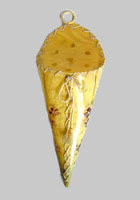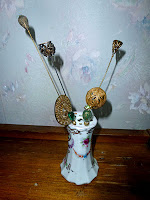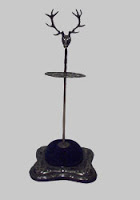| Charlene Raddon: THE HISTORY OF LADIES HAT PINS & A DRAWING
Posted: 25 Feb 2013 05:00 AM PST
Although prized by antique collectors today, hatpins were once both commonplace and controversial. Ranging between 6 and 12 inches long, depending on the size of the hat they needed to secure to a woman’s head, they were fancy or practical. Every available material was used in their manufacture; precious metals, gemstones, plastics and paste. Hatpin makers marketed their products to the various levels of society, ranging from the extremely ornate and expensive to the simple and functional. The heyday of the hatpin lasted from the 1880’s to 1920’s, after which hair styles became short and hats became smaller, making pins unnecessary. As far back as the Middle Ages in Britain and Europe, pins were used as a device to securely hold wimples and veils that proper ladies used to cover their hair. These wire pins were used for hundreds of years. In 1800 the making of decorative and functional pins became a cottage industry, frequently employing an entire family. Each pin was time-consuming to make, limiting the numbers of pins available to the demanding public. depending on the size of the hat they needed to secure to a woman’s head, they were fancy or practical. Every available material was used in their manufacture; precious metals, gemstones, plastics and paste. Hatpin makers marketed their products to the various levels of society, ranging from the extremely ornate and expensive to the simple and functional. The heyday of the hatpin lasted from the 1880’s to 1920’s, after which hair styles became short and hats became smaller, making pins unnecessary. As far back as the Middle Ages in Britain and Europe, pins were used as a device to securely hold wimples and veils that proper ladies used to cover their hair. These wire pins were used for hundreds of years. In 1800 the making of decorative and functional pins became a cottage industry, frequently employing an entire family. Each pin was time-consuming to make, limiting the numbers of pins available to the demanding public.
 One way to keep up with demand was to import from France. Parliament became alarmed at the effect the imports had on the balance of trade and, in 1820, passed an Act restricting the sale of pins to two days per year, January first and second. Ladies saved their money all year to be able to purchase pins, which may explain the term “pin money.” Queen Victoria, however, taxed her subjects at the beginning of each year to pay for her own pins, which may also have originated the term. One way to keep up with demand was to import from France. Parliament became alarmed at the effect the imports had on the balance of trade and, in 1820, passed an Act restricting the sale of pins to two days per year, January first and second. Ladies saved their money all year to be able to purchase pins, which may explain the term “pin money.” Queen Victoria, however, taxed her subjects at the beginning of each year to pay for her own pins, which may also have originated the term.
In 1832 a pin making machine was patented in the U. S. and the production of pins with long tapering points began,  usurping the hand-made ones. Within the next two years, England and France as well as Japan began production machine-made pins. Any woman wearing a hat undoubtedly had a hat pin holding it in place. These pins could be up to thirteen inches long with a quite sharp tip, providing Victorian women with a handy weapon. They were so threatening that one judge ordered suffragettes to remove their hats and hatpins, for fear they’d use them as weapons in his court. Arkansas and Illinois passed bills limiting the length of hatpins to 9 inches. If a lengthier pin were desired, a permit had to be applied for. usurping the hand-made ones. Within the next two years, England and France as well as Japan began production machine-made pins. Any woman wearing a hat undoubtedly had a hat pin holding it in place. These pins could be up to thirteen inches long with a quite sharp tip, providing Victorian women with a handy weapon. They were so threatening that one judge ordered suffragettes to remove their hats and hatpins, for fear they’d use them as weapons in his court. Arkansas and Illinois passed bills limiting the length of hatpins to 9 inches. If a lengthier pin were desired, a permit had to be applied for.
 In 1848, head coverings were merely another piece of clothing which changed with fashion. Bonnets came into being, employing ribbons and strings tied under the chin to hold them on. This coincided with the suffrage movement, as women were as eager to be free of bonnet strings as they were to declare their right of equality with men. In 1848, head coverings were merely another piece of clothing which changed with fashion. Bonnets came into being, employing ribbons and strings tied under the chin to hold them on. This coincided with the suffrage movement, as women were as eager to be free of bonnet strings as they were to declare their right of equality with men.
The rise in popularity of hatpins as a result of changing fashions in the late 19th and early 20th centuries saw the Charles Horner jewelry business becoming one of the British market leaders in good quality but mass produced hatpins. Some of the high quality makers in the U. S. were the Unger Bros., the William Link Co., the Paye & Baker Mfg. Co. and Tiffany & Co.
At the start of World War II, women took over the jobs vacated by men who had gone away to war. As they reported to work in the factories, shipyards and aircraft plants the wearing of hats fell out of fashion, along with hat pins, which is too bad because a lot of us today could use a good weapon as handy as our hats, now and then.
Resource Materials and Books The Collectors Encyclopedia of Hatpin and Hatpin Holders by Lillian Baker, Collector Books of Paducah, Kn. Out of print – available on the secondary market Baker’s Encyclopedia of Hatpins and Hatpin Holders, Schiffer Books Hatpins and Hatpin Holders an Illustrated Value Guide by Lillian Baker, Collector books Art Nouveau and Art Deco Jewelry by Lillian Baker, Collector books Hat Pins by Eve Eckstein and June Ferkins, Shire Publication ISBN 0 2478 0182 7 Hat Pins and Tie Pins by Alexandra M. Rhodes, Mackays of Chatham Ltd. publication ISBN 0 7188 2540 3 Charles Horner of Halifax. A Celebration of his Life and Work by Tom Lawson, GML Publishing. ISBN 0-9542354-0-1
Visit Charlene’s Website: http://www.charleneraddon.com/
Charlene first serious writing attempt came in 1980 when she awoke one morning from an unusually vivid and compelling dream. Deciding that  dream needed to be made into a book, she dug out an old portable typewriter and went to work. That book never sold, but her second one, Tender Touch, became a Golden Heart finalist and earned her an agent. Soon after, she signed a three book contract with Kensington Books. Five of Charlene’s western historical romances were published between 1994 and 1999: Taming Jenna, Tender Touch (1994 Golden Heart Finalist under the title Brianna), Forever Mine (1996 Romantic Times Magazine Reviewer’s Choice Award Nominee and Affaire de Coeur Reader/Writer Poll finalist), To Have and To Hold Affaire de Coeur Reader/Writer Poll finalist); and writing as Rachel Summers, The Scent of Roses. Forever Mine and Tender Touch are available as e-books and after January 24, To Have and To Hold will be as well. When not writing, Charlene loves to travel, crochet, needlepoint, research genealogy, scrapbook, and dye Ukrainian eggs. dream needed to be made into a book, she dug out an old portable typewriter and went to work. That book never sold, but her second one, Tender Touch, became a Golden Heart finalist and earned her an agent. Soon after, she signed a three book contract with Kensington Books. Five of Charlene’s western historical romances were published between 1994 and 1999: Taming Jenna, Tender Touch (1994 Golden Heart Finalist under the title Brianna), Forever Mine (1996 Romantic Times Magazine Reviewer’s Choice Award Nominee and Affaire de Coeur Reader/Writer Poll finalist), To Have and To Hold Affaire de Coeur Reader/Writer Poll finalist); and writing as Rachel Summers, The Scent of Roses. Forever Mine and Tender Touch are available as e-books and after January 24, To Have and To Hold will be as well. When not writing, Charlene loves to travel, crochet, needlepoint, research genealogy, scrapbook, and dye Ukrainian eggs.
http://www.charleneraddon.blogspot.com
See you day-after-tomorrow for Sunday Snippets |






